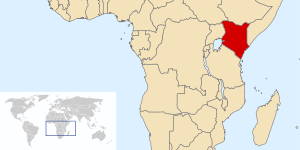Molo fire
An oil spill ignition occurred in Molo, Kenya, on January 31, 2009 and resulted in the deaths of at least 113 people and critical injuries to over 200 more. The incident occurred when an oil spill from an overturned truck burst into flames as onlookers attempted to obtain remnants of the spilled fuel for personal use. Rescuers suggested the cause to be static electricity, an accidentally-discarded cigarette, or an individual angered at a police blockade who sought vengeance.[1] Police have described the carnage as Kenya's worst disaster in recent times, occurring in a country hit by frequent fuel shortages and just days after a supermarket fire killed 25.[2] In June 2009, another similar accident occurred, when an oil tanker fire killed at least four and injured nearly 50 people at Kapokyek village near Kericho. The victims were siphoning fuel from the tanker that had fallen off the road.[3]
Kenyan disaster management
The fire was the second such disaster in Kenya that week, following the deaths of at least 25 people in a Nairobi supermarket when a branch of Nakumatt caught fire. The Kenyan media has been criticising the government for its poor safety standards and inadequate disaster preparation.[4] Following that blaze, the Daily Nation reported that Nairobi's three million inhabitants were served only by one fire station situated close to a traffic-choked business district.[5]
References
- ↑ "Kenya oil spill catches fire, kills 50". stuff.co.nz. 2009-01-31. Archived from the original on 2009-02-02. Retrieved 2009-01-31.
- ↑ "94 dead in Kenya petrol fire". RTÉ. 2009-02-01. Retrieved 2009-02-01.
- ↑ Daily Nation, June 19, 2009: Three more victims of oil tanker tragedy die
- ↑ "Kenya oil blaze kills more than 50". Reuters. 2009-01-31. Retrieved 2009-01-31.
- ↑ "Scores die in Kenyan oil blaze". Al Jazeera. 2009-01-31. Retrieved 2009-01-31.
